Effect of Acidified Sodium Silicate on the Flotation Separation of Microfine Apatite from Chlorite in Seawater
Abstract
1. Introduction
2. Materials and Methods
2.1. Pure Minerals and Reagents
2.2. Flotation Experiments
2.3. Zeta Potential Measurements
2.4. SEM Measurements
2.5. Adsorption Test
2.6. FTIR Analysis
2.7. Observation of Hydrophobic Agglomerates
3. Results and Discussion
3.1. Microfine Apatite and Chlorite Flotation Experiments
3.2. Zeta Potential Measurement
3.3. SEM–EDS Analysis
3.4. Adsorption Test
3.5. FTIR Analysis
3.6. Hydrophobic Agglomeration
3.7. Discussion
4. Conclusions
Author Contributions
Funding
Data Availability Statement
Conflicts of Interest
References
- Chen, Y.; Feng, Q.; Zhang, G.; Liu, D.; Liu, R. Effect of Sodium Pyrophosphate on the Reverse Flotation of Dolomite from Apatite. Minerals 2018, 8, 278–289. [Google Scholar] [CrossRef]
- Ruan, Y.; He, D.; Chi, R. Review on Beneficiation Techniques and Reagents Used for Phosphate Ores. Minerals 2019, 9, 253–271. [Google Scholar] [CrossRef]
- Yang, B.; Zhu, Z.; Sun, H.; Yin, W.; Hong, J.; Cao, S.; Tang, Y.; Zhao, C.; Yao, J. Improving flotation separation of apatite from dolomite using PAMS as a novel eco-friendly depressant. Miner. Eng. 2020, 156, 106492. [Google Scholar] [CrossRef]
- Yang, B.; Zhu, Z.; Yin, W.; Sun, Q.; Sun, H.; Han, H.; Sheng, Q.; Yao, J. Selective adsorption of an eco-friendly and efficient depressant PBTCA onto dolomite for effective flotation of fluorapatite from dolomite. Chem. Eng. J. 2020, 400, 125780. [Google Scholar] [CrossRef]
- Amirech, A.; Bouhenguel, M.; Kouachi, S. Two-stage reverse flotation process for removal of carbonates and silicates from phosphate ore using anionic and cationic collectors. Arab. J. Geosci. 2018, 11, 593. [Google Scholar] [CrossRef]
- Kato, Y.; Fujinaga, K.; Nakamura, K.; Takaya, Y.; Kitamura, K.; Ohta, J.; Toda, R.; Nakashima, T.; Iwamori, H. Deep-sea mud in the Pacific Ocean as a potential resource for rare-earth elements. Nat. Geosci. 2011, 4, 535–539. [Google Scholar] [CrossRef]
- Abouzeid, A.-Z.M.; Negm, A.; Elgillani, D.A. Upgrading of calcareous phosphate ores by flotation: Effect of ore characteristics. Int. J. Miner. Process 2009, 90, 81–89. [Google Scholar] [CrossRef]
- Liao, J.; Sun, X.; Li, D.; Sa, R.; Lu, Y.; Lin, Z.; Li, X.; Zhan, R.; Pan, Y.; Xu, H. New insights into nanostructure and geochemistry of bioapatite in REE-rich deep-sea sediments: LA-ICP-MS, TEM, and Z-contrast imaging studies. Chem. Geol. 2018, 512, 56–68. [Google Scholar] [CrossRef]
- Wang, T.; Feng, B.; Guo, Y.; Zhang, W.; Rao, Y.; Zhong, C.; Zhang, L.; Cheng, C.; Wang, H.; Luo, X. The flotation separation behavior of apatite from calcite using carboxymethyl chitosan as depressant. Miner. Eng. 2020, 159, 106635. [Google Scholar] [CrossRef]
- Santana, R.C.; Duarte, C.R.; Ataíde, C.H.; Barrozo, M.A.S. Flotation Selectivity of Phosphate Ore: Effects of Particle Size and Reagent Concentration. Sep. Sci. Technol. 2011, 46, 1511–1518. [Google Scholar] [CrossRef]
- Jeldres, R.I.; Forbes, L.; Cisternas, L.A. Effect of Seawater on Sulfide Ore Flotation: A Review. Miner. Process. Extr. Metall. Rev. 2016, 37, 369–384. [Google Scholar] [CrossRef]
- Chen, Y.; Chen, X.; Peng, Y. The effect of sodium hydrosulfide on molybdenite flotation in seawater and diluted seawater. Miner. Eng. 2020, 158, 106589. [Google Scholar] [CrossRef]
- Greenlee, L.F.; Lawler, D.F.; Freeman, B.D.; Marrot, B.; Moulin, P. Reverse osmosis desalination: Water sources, technology, and today’s challenges. Water Res. 2009, 43, 2317–2348. [Google Scholar] [CrossRef] [PubMed]
- Castro, S.; Laskowski, J.S. Froth Flotation in Saline Water. KONA Powder Part. J. 2011, 29, 4–15. [Google Scholar] [CrossRef]
- Jones, D.O.B.; Durden, J.M.; Murphy, K.; Gjerde, K.M.; Gebicka, A.; Colaço, A.; Morato, T.; Cuvelier, D.; Billett, D.S.M. Existing environmental management approaches relevant to deep-sea mining. Mar. Policy 2019, 103, 172–181. [Google Scholar] [CrossRef]
- Gu, G.; Song, S.; Du, S.; Wang, Y. The flotation behavior of chalcopyrite in the presence of bentonite in salt water containing Na+ and K+. Miner. Eng. 2022, 186, 107767. [Google Scholar] [CrossRef]
- Hirajima, T.; Suyantara, G.P.W.; Ichikawa, O.; Elmahdy, A.M.; Miki, H.; Sasaki, K. Effect of Mg2+ and Ca2+ as divalent seawater cations on the floatability of molybdenite and chalcopyrite. Miner. Eng. 2016, 96–97, 83–93. [Google Scholar] [CrossRef]
- Wang, B.; Peng, Y. The effect of saline water on mineral flotation–A critical review. Miner. Eng. 2014, 66–68, 13–24. [Google Scholar] [CrossRef]
- Castro, S.; Lopez-Valdivieso, A.; Laskowski, J. Review of the flotation of molybdenite. Part I: Surface properties and floatability. Int. J. Miner. Process. 2016, 148, 48–58. [Google Scholar] [CrossRef]
- Guimarães, R.C.; Araujo, A.C.; Peres, A.E.C. Reagents in igneous phosphate ores flotation. Miner. Eng. 2004, 18, 199–204. [Google Scholar] [CrossRef]
- Guan, C. Theoretical background of the Crago phosphate flotation process. Miner. Metall. Process. 2009, 26, 199–204. [Google Scholar] [CrossRef]
- Filippova, I.V.; Filippov, L.O.; Lafhaj, Z.; Barres, O.; Fornasiero, D. Effect of calcium minerals reactivity on fatty acids adsorption and flotation. Colloids Surf. A 2018, 545, 157–166. [Google Scholar] [CrossRef]
- Paiva, P.R.P.; Monte, M.B.M.; Simão, R.A.; Gaspar, J.C. In situ AFM study of potassium oleate adsorption and calcium precipitate formation on an apatite surface. Miner. Eng. 2011, 24, 387–395. [Google Scholar] [CrossRef]
- Zheng, G.; Liu, L.; Liu, J.; Wang, Y.; Cao, Y. Study of chlorite flotation and its influencing factors. Procedia Earth Planet. Sci. 2009, 1, 830–837. [Google Scholar]
- Feng, B.; Lu, Y.; Feng, Q. Interactions and Depression of Chlorite and Serpentine. Chin. J. Nonferrous Met. 2016, 40, 167–171. [Google Scholar]
- Feng, Q.; Feng, B.; Lu, Y. Influence of copper ions and calcium ions on adsorption of CMC on chlorite. Nonferrous Met. Soc. China 2013, 23, 237–242. [Google Scholar] [CrossRef]
- Wang, J.; Somasundaran, P. Adsorption and conformation of carboxymethyl cellulose at solid–liquid interfaces using spectroscopic, AFM and allied techniques. J. Colloid Interface Sci. 2005, 291, 75–83. [Google Scholar] [CrossRef]
- Guo, Y.; Fu, Z.; Ren, S. High-efficiency flotation of smithsonite in the presence of fine chlorite by using dispersant of sodium lignosulfonate. Colloids Surf. A 2022, 649, 129543. [Google Scholar] [CrossRef]
- Feng, B.; Luo, X.; Wang, J.; Wang, P. The flotation separation of scheelite from calcite using acidified sodium silicate as depressant. Miner. Eng. 2015, 80, 45–49. [Google Scholar]
- Tian, M.; Gao, Z.; Ji, B.; Fan, R.; Liu, R.; Chen, P.; Sun, W.; Hu, Y. Selective Flotation of Cassiterite from Calcite with Salicylhydroxamic Acid Collector and Carboxymethyl Cellulose Depressant. Minerals 2018, 8, 316–331. [Google Scholar] [CrossRef]
- Sun, C.; Yin, W. Principle of Silicate Minerals Flotation; Science Press: Beijing, China, 2001; pp. 254–304. [Google Scholar]
- Zhang, Z. The role of acid sodium silicate in phosphate ore flotation. China Non-Met. Min. Ind. 2003, 2, 39–41. [Google Scholar]
- Suyantara, G.P.W.; Hirajima, T.; Miki, H.; Sasaki, K. Floatability of molybdenite and chalcopyrite in artificial seawater. Miner. Eng. 2018, 115, 117–130. [Google Scholar] [CrossRef]
- Ding, Z.; Li, J.; Bi, Y.; Yu, P.; Dai, H.; Wen, S.; Bai, S. The adsorption mechanism of synergic reagents and its effect on apatite flotation in oleamide-sodium dodecyl benzene sulfonate (SDBS) system. Miner. Eng. 2021, 170, 107070. [Google Scholar] [CrossRef]
- Kou, J.; Tao, D.; Xu, G. Fatty acid collectors for phosphate flotation and their adsorption behavior using QCM-D. Int. J. Miner. Process. 2010, 95, 1–9. [Google Scholar] [CrossRef]
- Peng, Y.; Li, Y.; Li, W.; Fang, X.; Liu, C.; Fan, R. Elimination of adverse effects of seawater on molybdenite flotation using sodium silicate. Miner. Eng. 2020, 146, 106108. [Google Scholar] [CrossRef]
- Wang, L.; Lyu, W.; Li, F.; Liu, J.; Zhang, H. Discrepant adsorption behavior of sodium alginate onto apatite and calcite surfaces: Implications for their selective flotation separation. Miner. Eng. 2022, 181, 107553. [Google Scholar] [CrossRef]
- Zhong, C.; Feng, B.; Zhang, L.; Zhang, W.; Wang, H.; Gao, Z. Flotation separation of apatite and calcite using gum arabic as a depressant. Colloids Surf. A 2022, 632, 127723. [Google Scholar] [CrossRef]
- Halasz, I.; Agarwal, M.; Li, R.; Miller, N. Vibrational spectra and dissociation of aqueous Na2SiO3 solutions. Catal. Lett. 2007, 117, 34–42. [Google Scholar] [CrossRef]
- Cao, Q.; Cheng, J.; Wen, S.; Li, C.; Bai, S.; Liu, D. A mixed collector system for phosphate flotation. Miner. Eng. 2015, 78, 114–121. [Google Scholar] [CrossRef]
- Nan, N.; Zhu, Y.; Han, Y. Flotation performance and mechanism of α-Bromolauric acid on separation of hematite and fluorapatite. Miner. Eng. 2019, 132, 162–168. [Google Scholar] [CrossRef]
- Zou, S.; Wang, S.; Zhong, H.; Qin, W. Hydrophobic agglomeration of rhodochrosite fines in aqueous suspensions with sodium oleate. Powder Technol. 2021, 377, 186–193. [Google Scholar] [CrossRef]
- Yang, B.; Huang, P.; Song, S.; Luo, H.; Zhang, Y. Hydrophobic agglomeration of apatite fines induced by sodium oleate in aqueous solutions. Results Phys. 2018, 9, 970–977. [Google Scholar] [CrossRef]
- Deryagin, B.V.; Dukhin, S.S.; Rulev, N.N. Kinetic Theory of the Flotation of Small Particles. Russ. Chem. Rev. 1982, 51, 51–67. [Google Scholar] [CrossRef]
- Gong, W.; Parentich, A.; Little, L.; Warren, W. Adsorption of oleate on apatite studied by diffuse reflectance infrared Fourier transform spectroscopy. Langmuir 1992, 8, 118–124. [Google Scholar] [CrossRef]
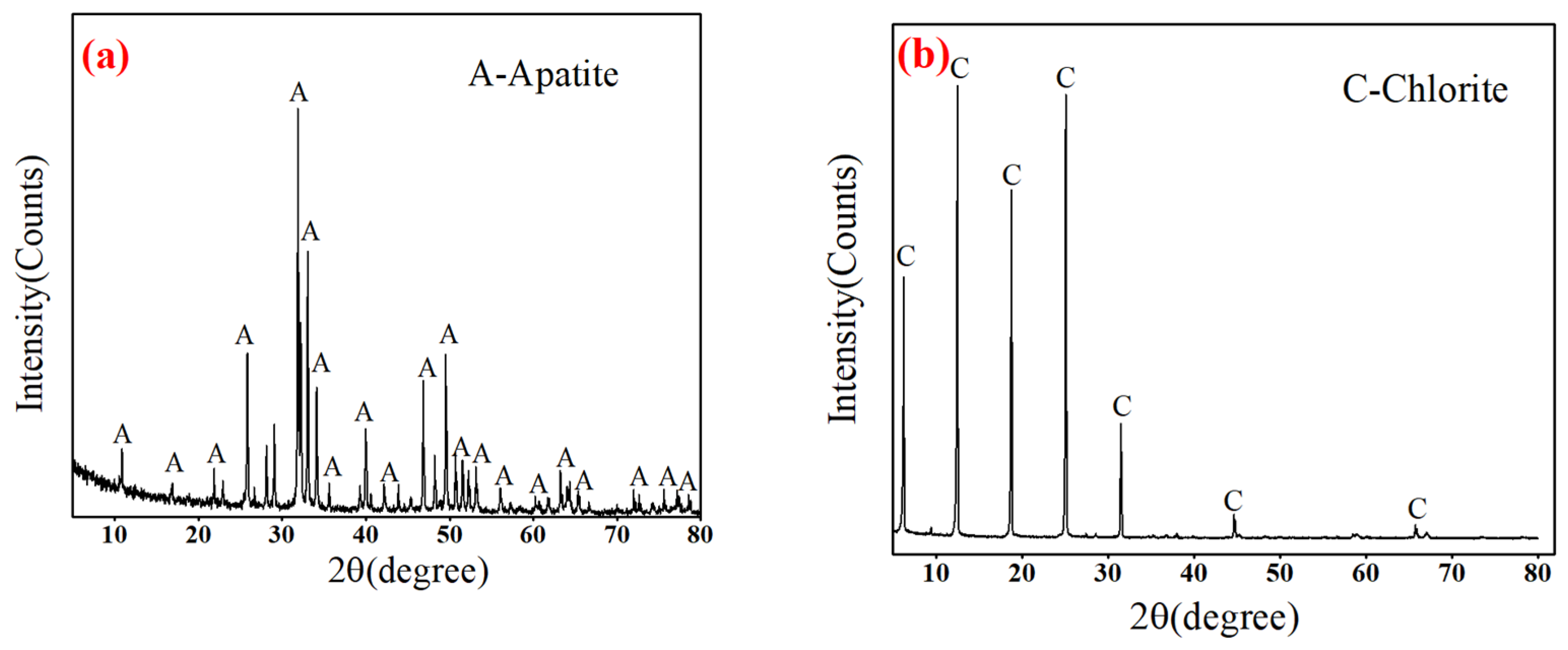
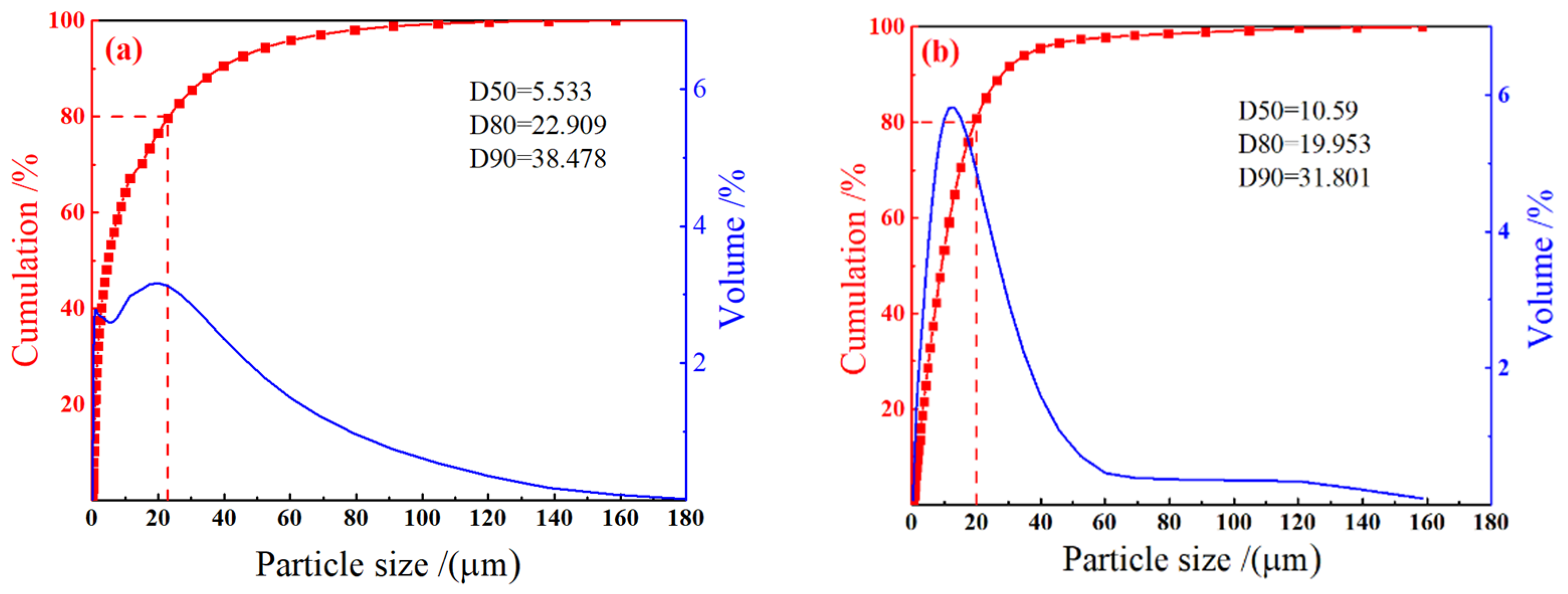
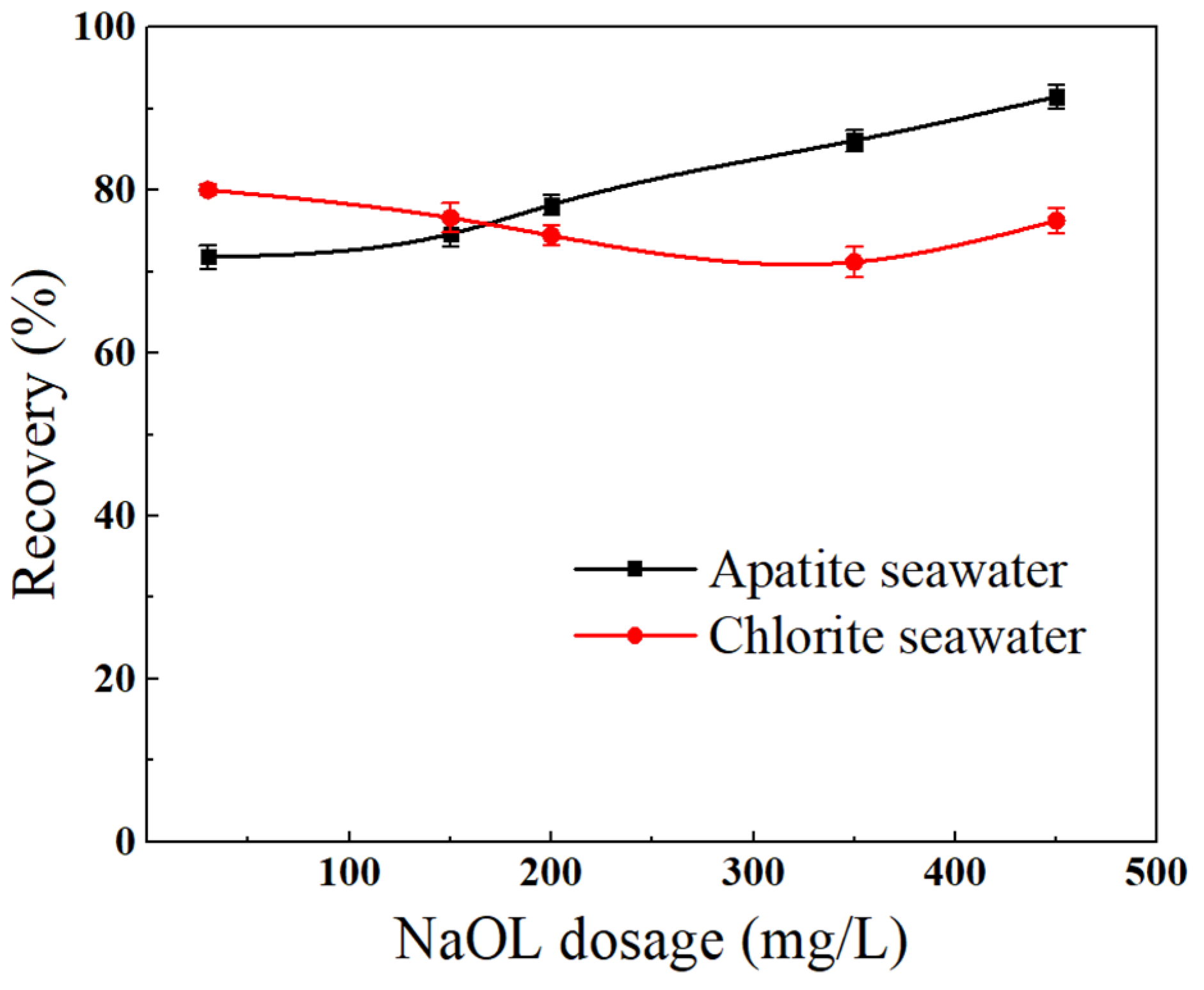

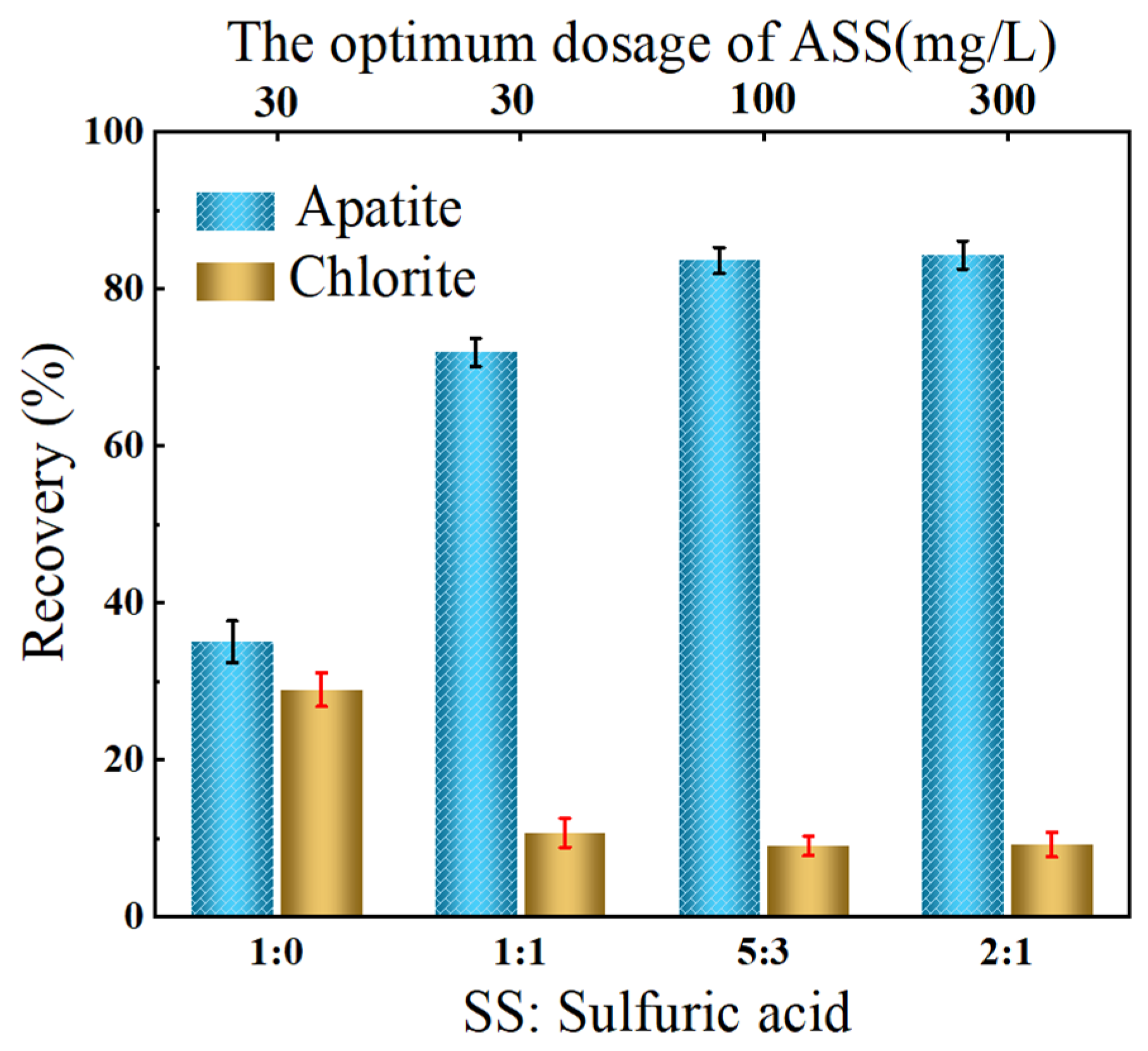
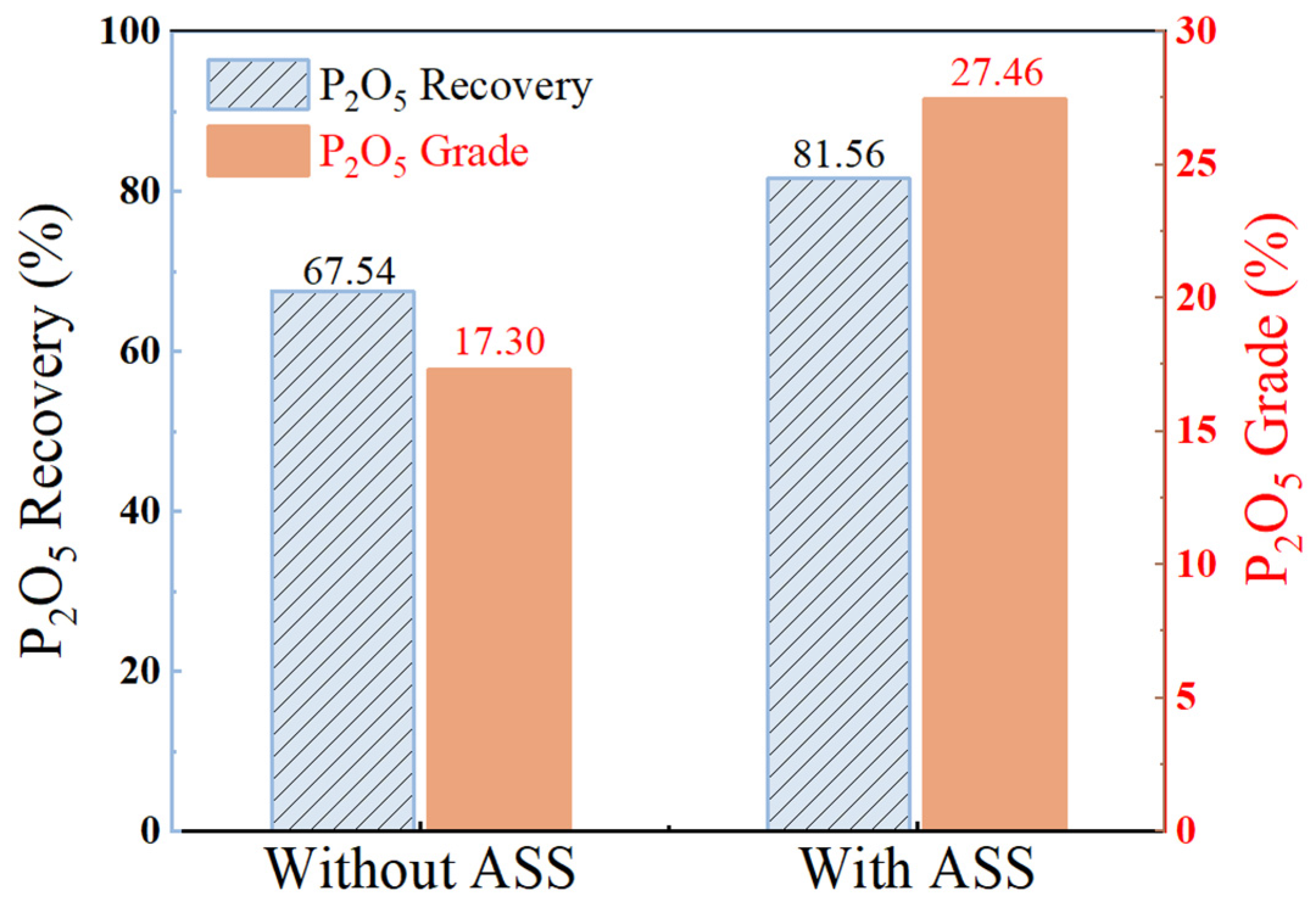
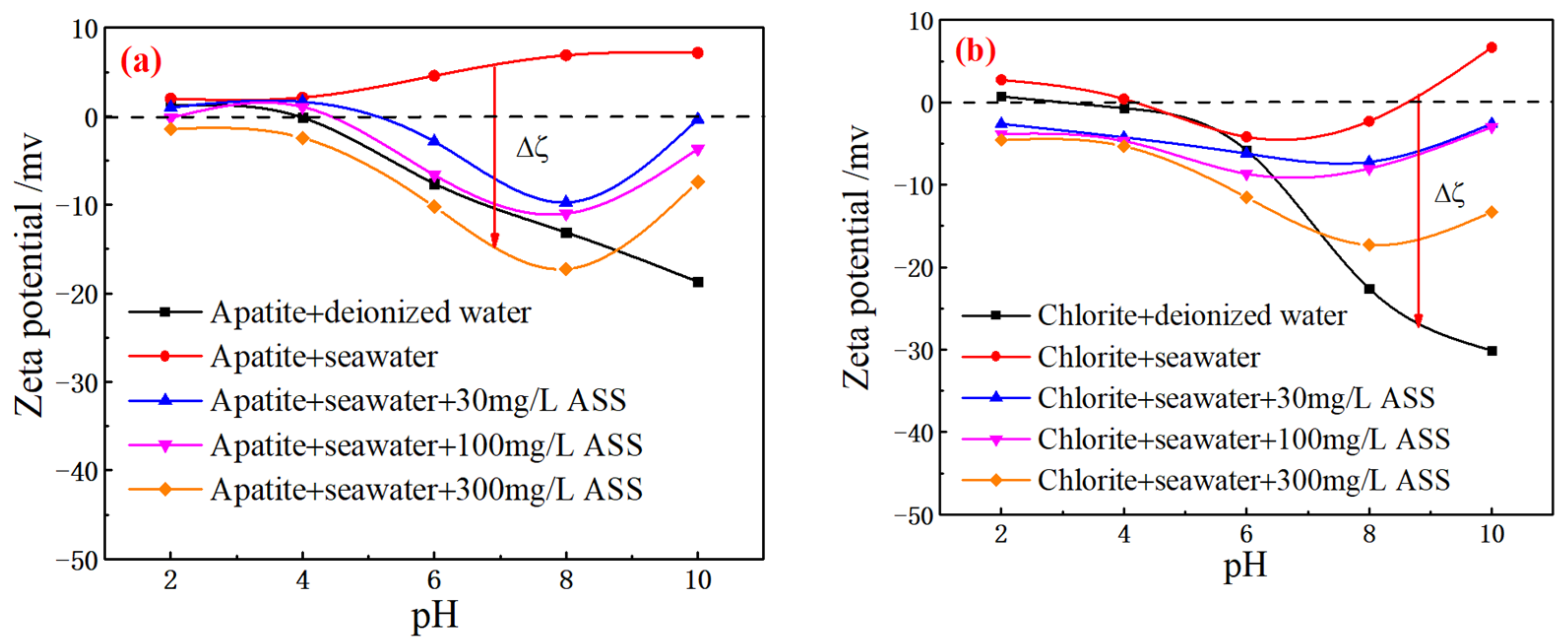
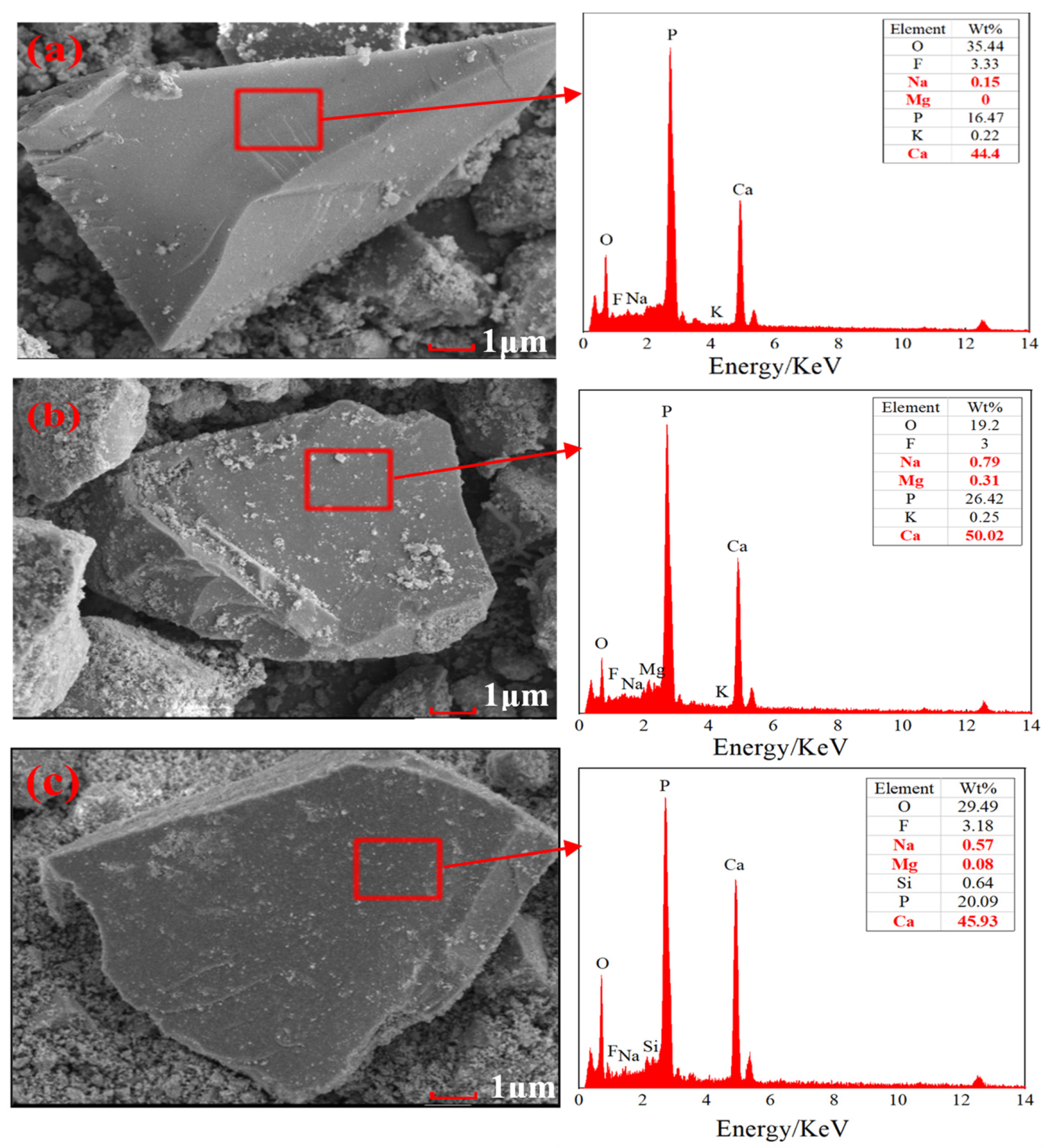



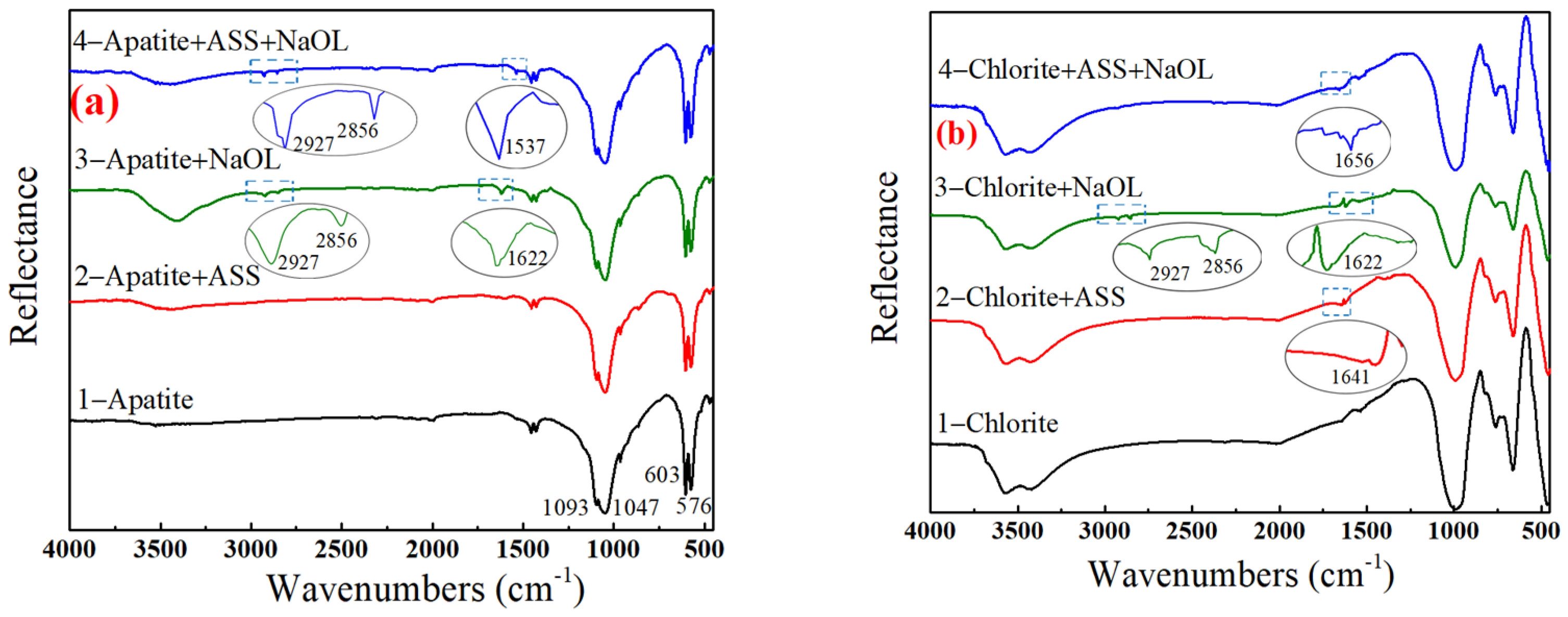
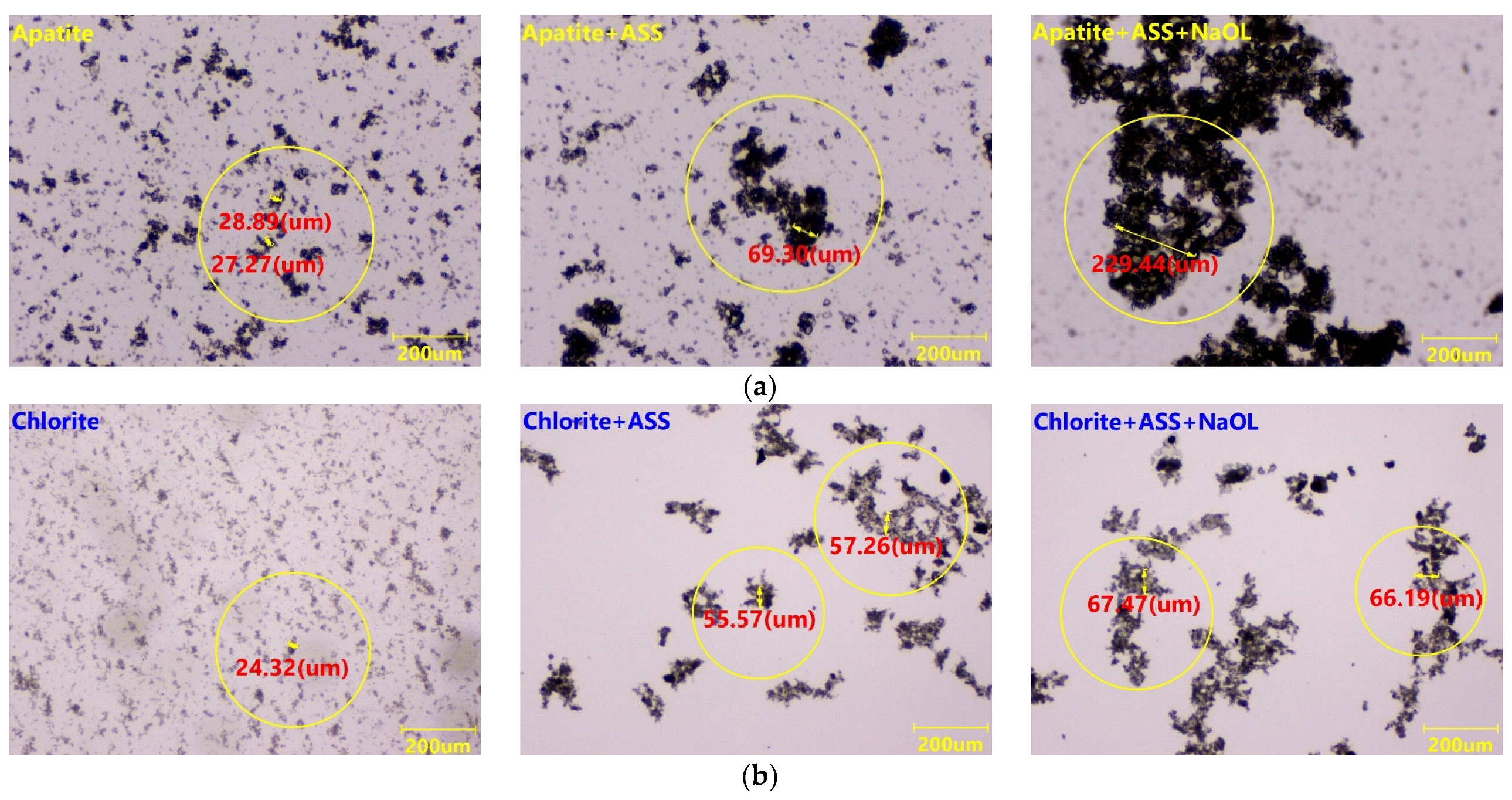

| NaCl | MgCl2 | MgSO4 | CaCl2 | NaHCO3 | KCl | NaBr |
|---|---|---|---|---|---|---|
| 26.60 | 2.628 | 3.186 | 1.26 | 0.51 | 0.715 | 0.216 |
Disclaimer/Publisher’s Note: The statements, opinions and data contained in all publications are solely those of the individual author(s) and contributor(s) and not of MDPI and/or the editor(s). MDPI and/or the editor(s) disclaim responsibility for any injury to people or property resulting from any ideas, methods, instructions or products referred to in the content. |
© 2023 by the authors. Licensee MDPI, Basel, Switzerland. This article is an open access article distributed under the terms and conditions of the Creative Commons Attribution (CC BY) license (https://creativecommons.org/licenses/by/4.0/).
Share and Cite
Liao, S.; Wu, Y.; Xiong, W.; Zhao, K.; Gu, G.; Wang, Y. Effect of Acidified Sodium Silicate on the Flotation Separation of Microfine Apatite from Chlorite in Seawater. Minerals 2023, 13, 1061. https://doi.org/10.3390/min13081061
Liao S, Wu Y, Xiong W, Zhao K, Gu G, Wang Y. Effect of Acidified Sodium Silicate on the Flotation Separation of Microfine Apatite from Chlorite in Seawater. Minerals. 2023; 13(8):1061. https://doi.org/10.3390/min13081061
Chicago/Turabian StyleLiao, Su, Yanming Wu, Wenliang Xiong, Kaile Zhao, Guohua Gu, and Yanhong Wang. 2023. "Effect of Acidified Sodium Silicate on the Flotation Separation of Microfine Apatite from Chlorite in Seawater" Minerals 13, no. 8: 1061. https://doi.org/10.3390/min13081061
APA StyleLiao, S., Wu, Y., Xiong, W., Zhao, K., Gu, G., & Wang, Y. (2023). Effect of Acidified Sodium Silicate on the Flotation Separation of Microfine Apatite from Chlorite in Seawater. Minerals, 13(8), 1061. https://doi.org/10.3390/min13081061








